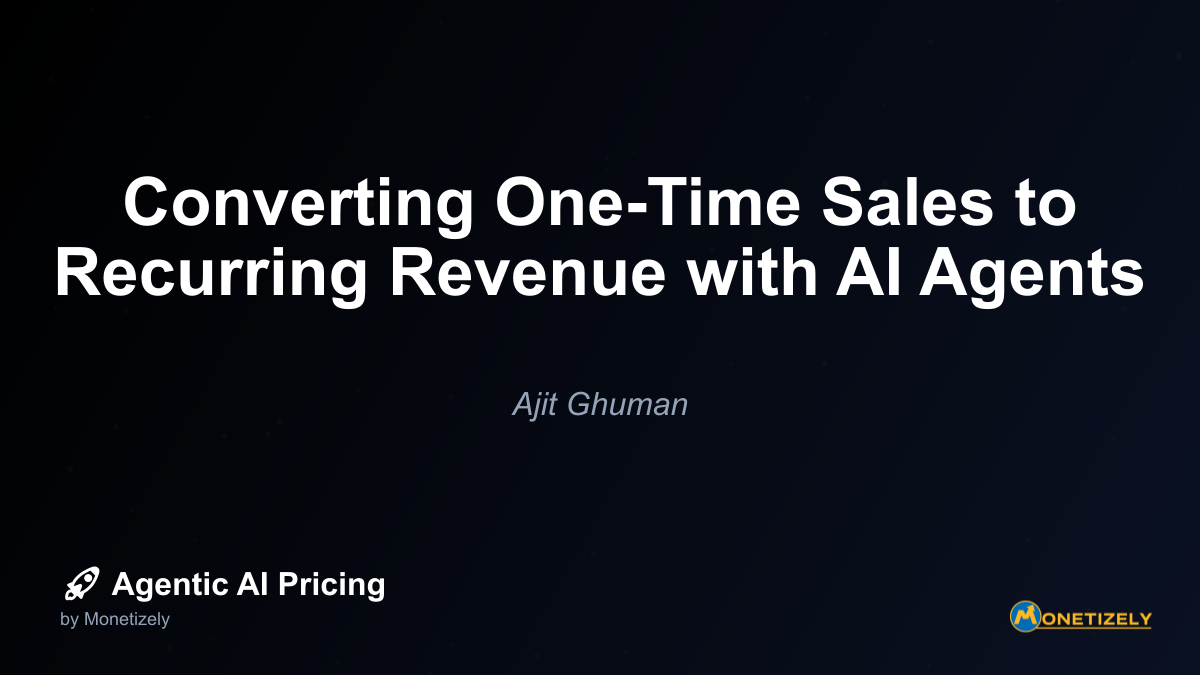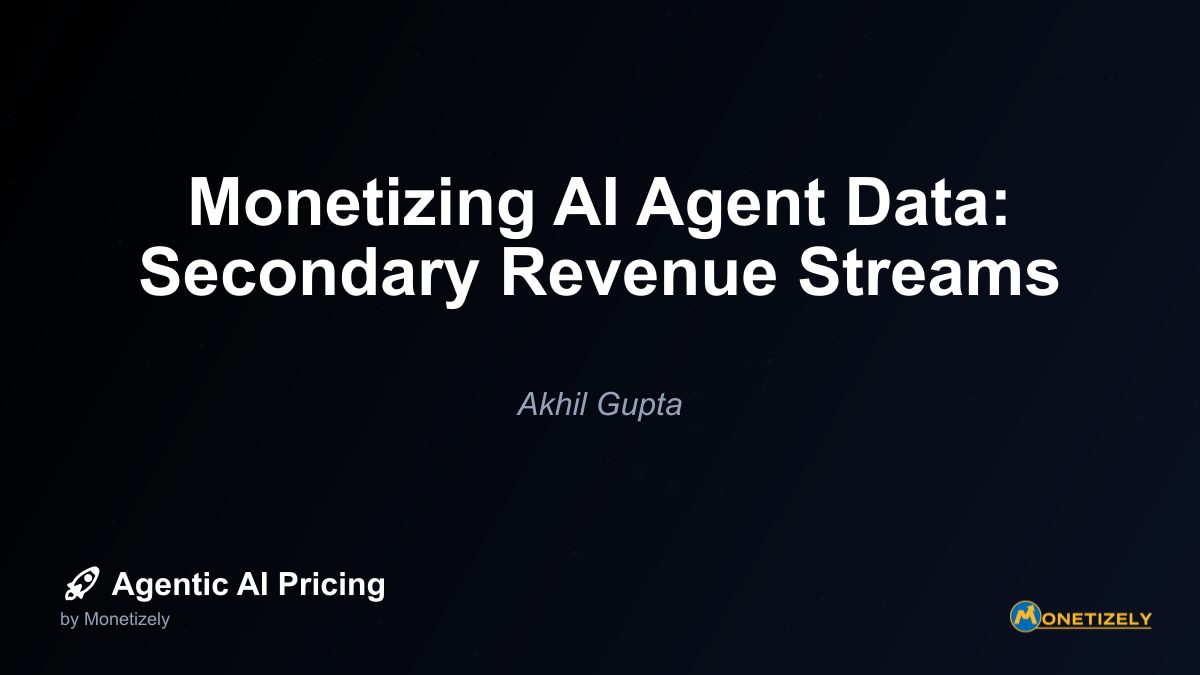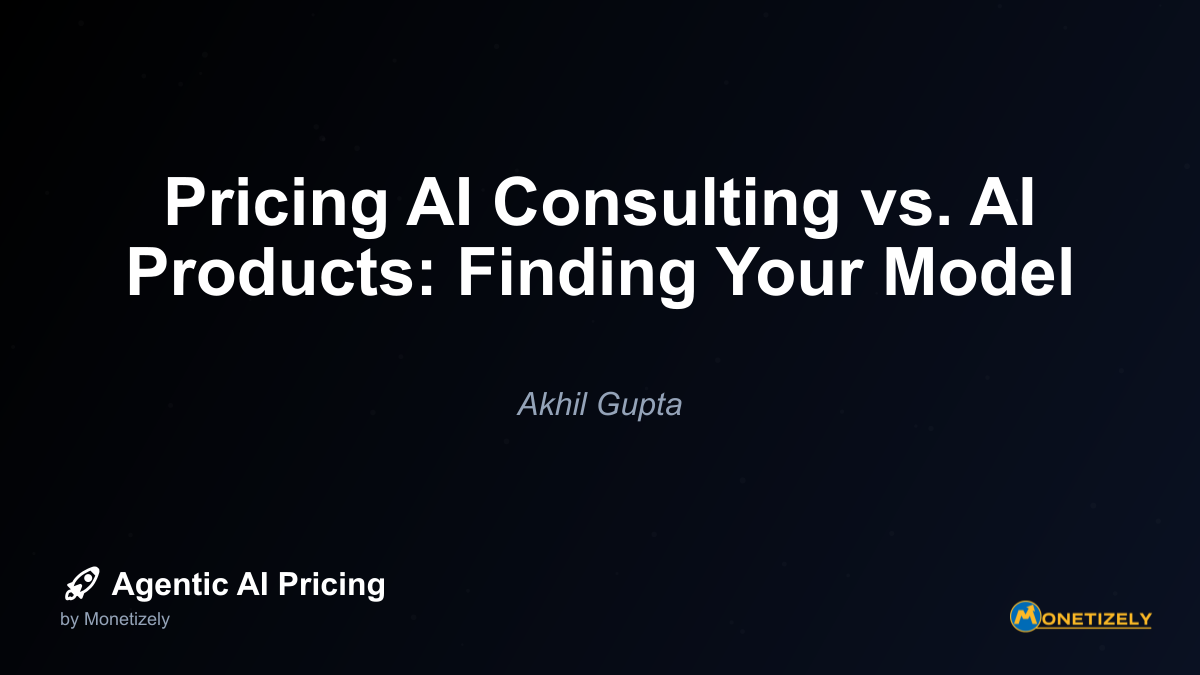· Ajit Ghuman · Business Models · 12 min read
Converting One-Time Sales to Recurring Revenue with AI Agents
AI and SaaS Pricing Masterclass
Learn the art of strategic pricing directly from industry experts. Our comprehensive course provides frameworks and methodologies for optimizing your pricing strategy in the evolving AI landscape. Earn a professional certification that can be imported directly to your LinkedIn profile.

In today’s rapidly evolving software landscape, traditional perpetual licensing models are increasingly becoming obsolete. The shift from one-time sales to recurring revenue models represents not just a pricing change, but a fundamental business transformation. With the advent of AI technologies, this transition offers unprecedented opportunities for software companies to create sustainable growth, deeper customer relationships, and predictable revenue streams.
The Strategic Imperative: Why Convert to Recurring Revenue?
The software industry has witnessed a seismic shift in business models over the past decade. By 2023, 95% of businesses had adopted SaaS technologies, marking a 71% increase from just five years earlier. This trend shows no signs of slowing, with 85% of all business applications expected to be SaaS-based by 2025.
This transformation is driven by compelling business advantages:
Financial Stability: Recurring revenue creates predictable cash flows, reducing business volatility and improving forecasting accuracy. This predictability is particularly valued by investors, often resulting in higher valuation multiples (25-95% higher when retention improves by just 5%).
Customer Lifetime Value: Subscription models fundamentally change the customer relationship from a one-time transaction to an ongoing partnership. This extended relationship creates opportunities to deliver continuous value, resulting in higher lifetime customer value.
Competitive Necessity: As markets mature, customer expectations shift. Modern buyers increasingly prefer the flexibility, lower initial investment, and continuous improvement that subscription models offer. Companies that fail to adapt risk market irrelevance.
Innovation Velocity: Recurring revenue models enable faster innovation cycles, allowing companies to quickly deploy new features and capabilities without the friction of major version upgrades.
AI as the Transformation Catalyst
Artificial intelligence represents the perfect catalyst for this business model transformation. AI technologies offer unique capabilities that both facilitate the transition and enhance the value of subscription offerings:
Predictive Capabilities
AI excels at identifying patterns in customer behavior that humans might miss. This predictive power enables software companies to:
- Forecast churn risk with remarkable accuracy, allowing for proactive intervention
- Identify upsell and cross-sell opportunities based on usage patterns
- Optimize pricing strategies through dynamic segmentation and willingness-to-pay analysis
- Predict customer lifetime value to prioritize retention efforts
Personalization at Scale
Modern customers expect personalized experiences, but delivering this at scale has traditionally been challenging. AI changes this equation:
- Tailors product experiences based on individual user behavior and preferences
- Customizes communication cadence and content to match customer engagement patterns
- Delivers contextually relevant recommendations that increase product adoption
- Creates personalized onboarding experiences that improve initial value realization
Automation of Complex Workflows
The transition to subscription models often requires managing more complex customer journeys. AI can automate these processes:
- Streamlines subscription billing, renewals, and payment processing
- Automates customer support through intelligent chatbots and self-service tools
- Manages subscription lifecycle events from trial to renewal
- Orchestrates multi-channel customer engagement based on behavioral triggers
The Transformation Roadmap: From One-Time to Recurring Revenue
Converting from traditional licensing to subscription models requires a strategic, phased approach. Based on successful transitions across the software industry, here’s a comprehensive framework:
Phase 1: Strategic Foundation (3-6 months)
Market Assessment and Competitive Analysis
Begin by thoroughly analyzing your market landscape and competitive positioning. This includes:
- Evaluating competitor pricing models and subscription offerings
- Assessing customer readiness for subscription adoption
- Identifying market segments most receptive to subscription models
- Analyzing pricing sensitivity across different customer segments
Value Proposition Refinement
The success of your subscription model hinges on a compelling value proposition that justifies recurring payments:
- Identify ongoing value delivery mechanisms beyond the initial software purchase
- Develop AI-enhanced features that improve with continued usage
- Create clear differentiation from perpetual licensing options
- Establish value metrics that align pricing with customer-perceived value
Financial Modeling and Transition Planning
Prepare detailed financial models to understand the transition’s impact:
- Project cash flow changes during the transition period
- Model customer lifetime value under subscription scenarios
- Develop compensation plans that incentivize subscription sales
- Create transition incentives for existing customers
Phase 2: Operational Readiness (4-8 months)
Technology Infrastructure Development
Build the technical foundation to support subscription management:
- Implement subscription billing and management platforms
- Develop AI capabilities for customer segmentation and personalization
- Create customer health monitoring systems for churn prediction
- Establish data pipelines for usage analytics and behavioral insights
Team Structure and Skills Development
Subscription models require different organizational capabilities:
- Develop customer success functions focused on retention and expansion
- Train sales teams on subscription selling methodologies
- Build data science capabilities for AI-driven customer insights
- Create cross-functional teams aligned around customer lifetime value
Metrics and KPI Framework
Establish new performance indicators aligned with subscription success:
- Monthly Recurring Revenue (MRR) and Annual Recurring Revenue (ARR)
- Customer Acquisition Cost (CAC) and Customer Lifetime Value (CLV)
- Net Revenue Retention (NRR) and Gross Revenue Retention (GRR)
- Product engagement and feature adoption metrics
- AI model performance metrics (prediction accuracy, personalization effectiveness)
Phase 3: Market Introduction (3-6 months)
Pilot Program Launch
Test your subscription model with a controlled customer segment:
- Select receptive customers for initial subscription offerings
- Implement AI-powered personalization for the pilot group
- Gather detailed feedback on pricing, packaging, and value perception
- Refine offerings based on pilot performance data
Transition Strategy for Existing Customers
Develop a thoughtful approach for migrating current customers:
- Create incentive programs for voluntary migration
- Develop grandfathering options for hesitant customers
- Implement AI-driven segmentation to tailor transition approaches
- Establish clear timelines for legacy product support
Go-to-Market Strategy Refinement
Prepare for broader market introduction:
- Develop messaging that emphasizes subscription benefits
- Train sales and marketing teams on new value propositions
- Create educational content explaining the transition rationale
- Implement AI-powered lead scoring and opportunity prioritization
Phase 4: Scaling and Optimization (Ongoing)
AI-Driven Customer Success
Leverage AI to drive retention and expansion:
- Implement predictive churn models to identify at-risk customers
- Deploy personalized engagement campaigns based on usage patterns
- Use AI to identify expansion opportunities within customer accounts
- Automate routine customer success workflows
Continuous Pricing Optimization
Use data and AI to refine your pricing strategy:
- Analyze price sensitivity across customer segments
- Test pricing variations using controlled experiments
- Implement dynamic pricing based on value metrics
- Optimize packaging based on feature adoption data
Feedback Loop Integration
Create systems for continuous improvement:
- Establish customer advisory boards for subscription model feedback
- Implement AI-powered sentiment analysis across customer touchpoints
- Create rapid experimentation frameworks for testing new offerings
- Develop dashboards for monitoring subscription health metrics
AI Agent Capabilities for Subscription Management
Modern AI agents offer powerful capabilities specifically designed for subscription management and customer retention. These capabilities extend far beyond simple automation, creating intelligent systems that can proactively manage the entire customer lifecycle.
Predictive Churn Prevention
AI agents excel at identifying customers at risk of cancellation before they take action:
- Behavioral Analysis: AI models analyze patterns like declining usage, reduced feature adoption, or changes in support ticket frequency to identify early warning signs.
- Sentiment Detection: Natural language processing capabilities assess customer sentiment across support interactions, survey responses, and community engagement.
- Comparative Modeling: AI compares current customer behavior against historical patterns from previously churned accounts to predict future actions.
- Intervention Timing: Agents determine the optimal moment for human intervention, balancing urgency against the risk of appearing intrusive.
According to SuperAGI research, companies implementing AI-driven churn prediction have seen retention improvements of 20-30%, directly translating to millions in preserved revenue.
Personalized Engagement Orchestration
AI agents create tailored customer journeys that evolve based on individual behavior:
- Content Personalization: Automatically customize educational content, feature announcements, and value reinforcement messages based on usage patterns and preferences.
- Channel Optimization: Determine the most effective communication channels (email, in-app, SMS) for each customer based on historical engagement data.
- Timing Intelligence: Schedule communications during periods of highest receptivity and engagement probability.
- Value Demonstration: Highlight specific product benefits and ROI metrics most relevant to each customer’s objectives and usage patterns.
Renewal Management Automation
AI agents streamline the renewal process to maximize retention:
- Renewal Risk Assessment: Analyze multiple factors including usage trends, support history, and competitive signals to score renewal likelihood.
- Pricing Optimization: Recommend optimal renewal pricing based on usage volume, feature adoption, and customer expansion potential.
- Multi-Year Conversion: Identify candidates for multi-year agreements based on stability signals and offer personalized incentives.
- Escalation Workflows: Automatically trigger appropriate human involvement for high-risk or high-value renewals.
Renewal Manager AI agents have demonstrated the ability to recover 20-30% of at-risk renewals through proactive, personalized intervention strategies.
Expansion Revenue Generation
AI agents identify and capitalize on growth opportunities within existing accounts:
- Feature Recommendation: Suggest relevant unused features based on similar customer adoption patterns and business needs.
- Usage-Based Upselling: Identify accounts approaching usage limits and trigger timely upgrade conversations.
- Cross-Sell Opportunity Detection: Analyze usage patterns to recommend complementary products or services.
- Value Realization Tracking: Monitor and communicate ROI metrics to justify expansion investments.
Customer Health Monitoring
AI agents maintain continuous awareness of customer satisfaction and engagement:
- Health Score Calculation: Combine multiple signals including usage frequency, feature adoption, support interactions, and community engagement into comprehensive health metrics.
- Trend Analysis: Track health score trajectories over time to identify gradual declines requiring intervention.
- Benchmark Comparison: Compare individual customer health against similar accounts to identify relative performance issues.
- Automated Interventions: Trigger appropriate actions based on health score changes, from educational content to executive outreach.
Financial Implications of the Transition
The shift from one-time sales to subscription revenue fundamentally changes a company’s financial profile. Understanding and preparing for these changes is critical for a successful transition.
Short-Term Revenue Impact
The transition typically creates a temporary revenue dip as large upfront payments are replaced by smaller recurring payments:
- Revenue Recognition Changes: Revenue that was previously recognized immediately is now spread over the subscription period, creating a “revenue trough.”
- Cash Flow Implications: Similarly, cash flow patterns shift from large, irregular inflows to smaller, predictable monthly or annual payments.
- Transition Period Duration: The depth and duration of this trough depend on transition speed, with faster transitions creating deeper but shorter impacts.
Mitigation Strategies:
- Implement hybrid models during transition, offering both perpetual and subscription options
- Create financial incentives for annual or multi-year prepayment to improve cash flow
- Develop clear investor communication strategies explaining the long-term benefits
- Use AI to identify optimal transition timing for different customer segments
Long-Term Financial Benefits
Despite short-term challenges, the long-term financial benefits are substantial:
- Revenue Predictability: Subscription models create highly predictable revenue streams, reducing forecasting uncertainty.
- Valuation Multiples: SaaS companies typically command higher valuation multiples (7-15x revenue) compared to traditional software companies (2-4x revenue).
- Customer Lifetime Value: Successful subscription businesses often achieve 3-5x higher customer lifetime value compared to one-time sales models.
- Reduced Customer Acquisition Costs: The focus on retention reduces the relative cost of customer acquisition over time.
Key Financial Metrics for Transition Monitoring
Track these critical metrics to navigate the transition successfully:
- Net Revenue Retention (NRR): Measures revenue from existing customers over time, accounting for churn, downgrades, and expansion. Elite SaaS companies achieve 120%+ NRR.
- Customer Acquisition Cost (CAC) Payback Period: The time required to recover the cost of acquiring a customer. Target is typically 12-18 months for healthy subscription businesses.
- CAC:LTV Ratio: The ratio of customer acquisition cost to lifetime value. Target is 1:3 or better.
- Gross Margin: Subscription businesses should target 70-80%+ gross margins to support growth investments.
- Rule of 40: The sum of growth rate and profit margin should exceed 40% for well-performing subscription businesses.
AI-Enhanced Financial Modeling
AI capabilities can significantly improve financial forecasting during the transition:
- Churn Prediction: AI models can predict churn probability at the individual customer level, improving revenue forecasting accuracy.
- Expansion Revenue Modeling: AI can analyze usage patterns to forecast expansion revenue potential across the customer base.
- Scenario Analysis: Machine learning can simulate thousands of transition scenarios to identify optimal strategies.
- Cash Flow Optimization: AI can recommend ideal timing for transition initiatives to minimize cash flow disruption.
Customer Segmentation for Targeted Transition
Not all customers are equally receptive to subscription models. Effective segmentation is essential for a successful transition strategy.
Value-Based Segmentation
Segment customers based on their perceived value from your solution:
- Business-Critical Users: Customers who rely heavily on your software for core operations are often more receptive to subscriptions that ensure continuous access and support.
- Cost-Sensitive Adopters: Price-conscious customers may resist subscription models unless clear cost advantages can be demonstrated.
- Feature Enthusiasts: Customers who regularly adopt new features value the continuous innovation of subscription models.
- Compliance-Driven Users: Organizations in regulated industries may prefer subscriptions that ensure continuous compliance updates.
Behavioral Segmentation
Analyze usage patterns to identify subscription readiness:
- Engagement Frequency: Customers with regular, frequent engagement are natural subscription candidates.
- Feature Adoption Breadth: Users who leverage multiple product features typically see higher value in comprehensive subscriptions.
- Support Utilization: High-support customers often recognize the value of subscription-based service levels.
- Update Adoption: Customers who promptly install updates value the continuous improvement aspect of subscriptions.
AI-Powered Micro-Segmentation
Modern AI enables highly granular segmentation approaches:
- Propensity Modeling: AI can calculate each customer’s likelihood to convert to subscription based on dozens of behavioral and firmographic factors.
- Value Perception Analysis: Natural language processing can analyze customer communications to assess perceived value and price sensitivity.
- Optimal Timing Prediction: AI can identify ideal moments in the customer lifecycle for subscription conversion efforts.
- Custom Offer Generation: AI can design personalized transition offers tailored to each customer’s specific needs and concerns.
Transition Strategy by Segment
Develop targeted approaches for each customer segment:
- High-Value, High-Readiness: Prioritize these customers for early transition with premium offerings and white-glove migration support.
- High-Value, Low-Readiness: Implement gradual education programs highlighting subscription benefits before transition attempts.
- Low-Value, High-Readiness: Offer streamlined self-service transition paths with appropriate incentives.
- Low-Value, Low-Readiness: Consider maintaining perpetual options for this segment or creating entry-level subscription tiers.
Pricing Strategy for AI-Enhanced Subscriptions
Effective pricing is perhaps the most critical element of a successful subscription transformation. AI capabilities create new opportunities for sophisticated pricing approaches.
Value Metric Selection
The foundation of subscription pricing is selecting the right value metric—what you charge for:
- User-Based: Charging per user works well for collaboration tools and platforms where individual access drives value.
- Usage-Based: Pricing based on consumption (API calls, storage, processing time) aligns cost with value for computational services.
- Outcome-Based: Advanced AI enables charging based on results achieved (conversions, efficiency gains, cost savings).
- Hybrid Approaches: Combining multiple metrics can balance predictability with value alignment.
For AI-enhanced offerings, common value metrics include:
- AI Processing Units: Based on computational resources consumed
- Intelligent Interactions: Measured by API calls or agent interactions
- Decision Support Volume: Based on AI-assisted decisions or recommendations
- Automation Value: Tied to time or cost savings from AI automation
Tiered Pricing Structures
Most successful subscription models employ tiered pricing to address different market segments:
- Feature-Based Tiers: Different AI capabilities are available at each tier
- Scale-Based Tiers: Similar features with different usage limits
- Service-Level Tiers: Varying levels of support, SLAs, and human oversight
- AI Performance Tiers: Different levels of model accuracy, response time, or customization
AI-Powered Dynamic Pricing
Advanced AI enables more sophisticated pricing approaches:
- Behavioral Pricing: Adjusting offers based on observed usage patterns
- Predictive Value Pricing: Setting prices based on forecasted value realization
- Competitive Response Pricing: Dynamically adjusting to market conditions
- Willingness-to-Pay Analysis: Using AI to identify optimal price points by segment
Pricing Psychology Considerations
Effective subscription pricing leverages psychological principles:
- Anchoring: Presenting premium tiers first to make standard offerings seem more affordable
- Decoy Options: Including options designed to make target tiers more attractive by comparison
- Bundling: Combining features to increase perceived value and reduce price sensitivity
- Transparency: Clearly communicating value to build trust, especially for AI features that may seem opaque
Change Management: The Human Side of
- recurring-revenue
- subscription-models
- business-model-transformation
- saas-transition
- revenue-predictability
Co-Founder & CEO
Ajit is the author of Price To Scale, a top book on SaaS Pricing and is the Founder of Monetizely. Ajit has led and worked in pricing and product marketing at firms like Twilio, Narvar and Medallia. His work has been featured in Forbes and VentureBeat. Ajit regularly consults with software companies from Seed stage to post-IPO on pricing strategy. Ajit is also a highly-rated co-instructor for 'The Art of SaaS Pricing and Monetization' on Maven.
Pricing Strategy Audit
Let our experts analyze your current pricing strategy and identify opportunities for improvement. Our data-driven assessment will help you unlock untapped revenue potential and optimize your AI pricing approach.




